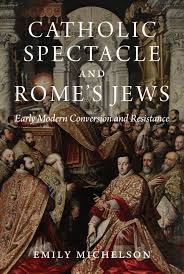Catholic Spectacle and Rome's Jews
Early Modern Conversion and Resistance
- ISBN: 9780691233413
- Editorial: Princeton University Press
- Fecha de la edición: 2024
- Lugar de la edición: Princeton (NJ). Estados Unidos de Norteamérica
- Encuadernación: Rústica
- Medidas: 24 cm
- Nº Pág.: 352
- Idiomas: Inglés

A new investigation that shows how conversionary preaching to Jews was essential to the early modern Catholic Church and the Roman religious landscape
Starting in the sixteenth century, Jews in Rome were forced, every Saturday, to attend a hostile sermon aimed at their conversion. Harshly policed, they were made to march en masse toward the sermon and sit through it, all the while scrutinized by local Christians, foreign visitors, and potential converts. In Catholic Spectacle and Rome's Jews, Emily Michelson demonstrates how this display was vital to the development of early modern Catholicism.
Drawing from a trove of overlooked manuscripts, Michelson reconstructs the dynamics of weekly forced preaching in Rome. As the Catholic Church began to embark on worldwide missions, sermons to Jews offered a unique opportunity to define and defend its new triumphalist, global outlook. They became a point of prestige in Rome. The city's most important organizations invested in maintaining these spectacles, and foreign tourists eagerly attended them. The title of "Preacher to the Jews" could make a man's career. The presence of Christian spectators, Roman and foreign, was integral to these sermons, and preachers played to the gallery. Conversionary sermons also provided an intellectual veneer to mask ongoing anti-Jewish aggressions. In response, Jews mounted a campaign of resistance, using any means available.
Examining the history and content of sermons to Jews over two and a half centuries, Catholic Spectacle and Rome's Jews argues that conversionary preaching to Jews played a fundamental role in forming early modern Catholic identity.






